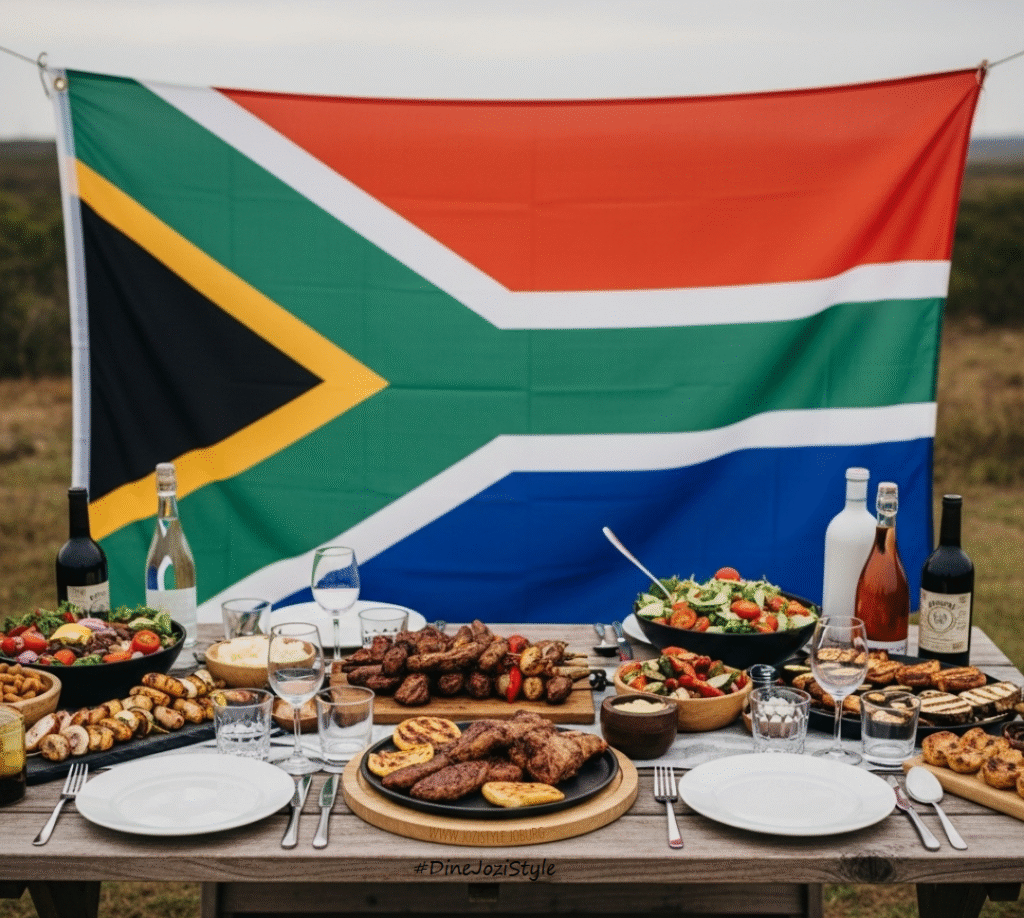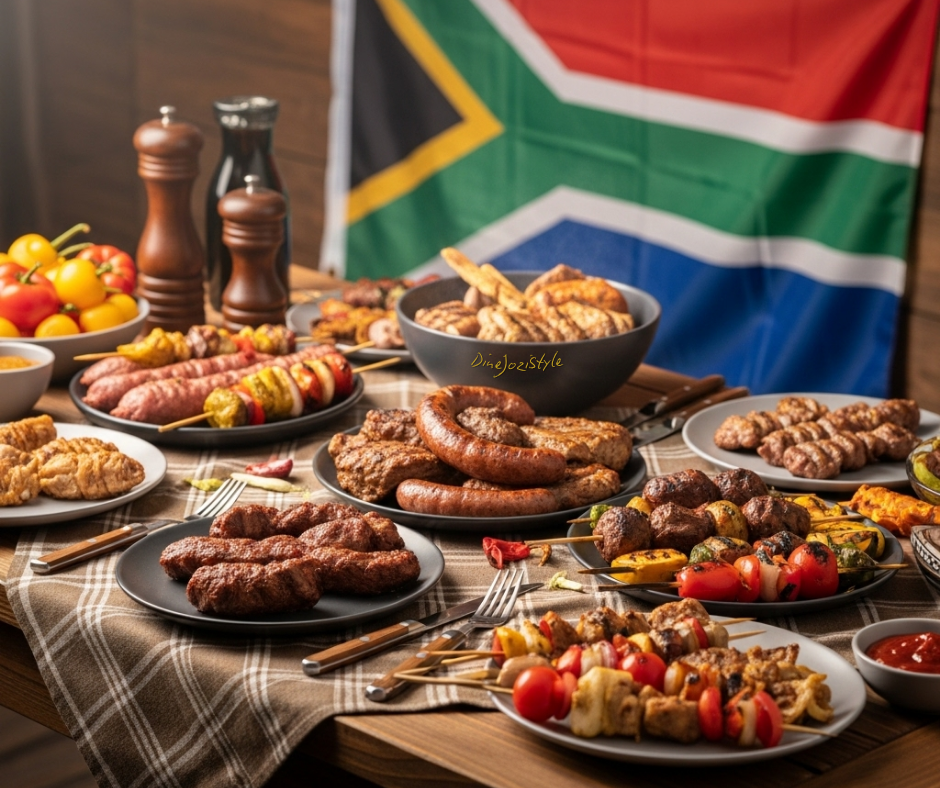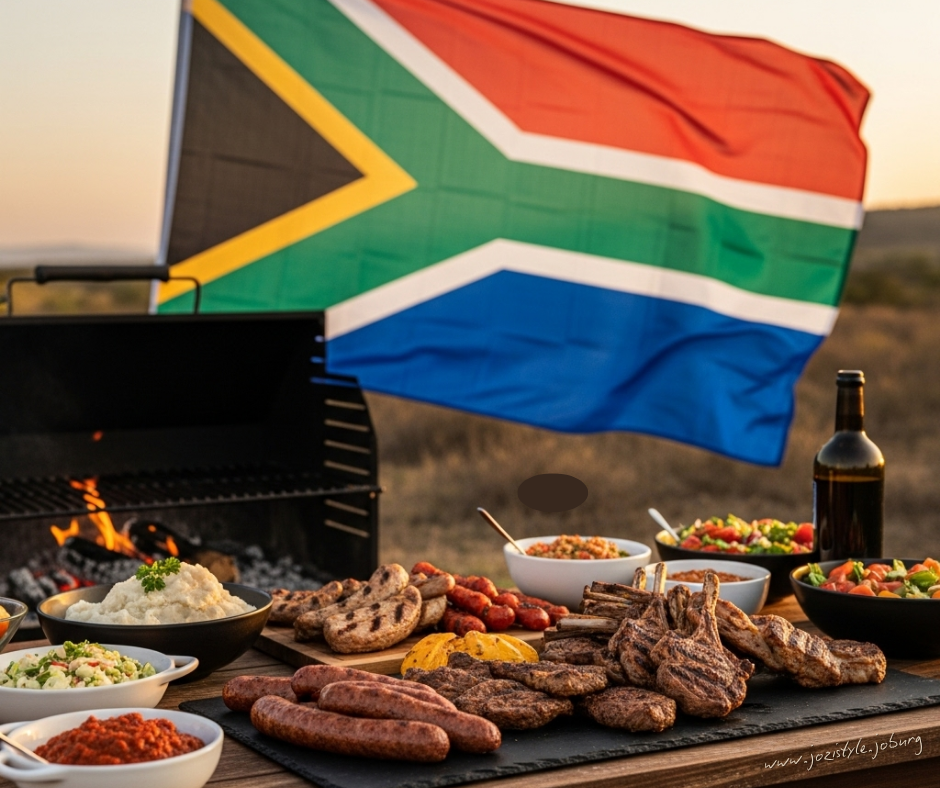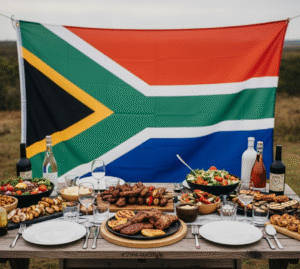What Makes a South African Braai Unique? Tips, Recipes, and Traditions You Need to Know

Over the last couple of weeks, I’ve been talking about my favourite cuisines from around the world. And I thought, everything is better at home. Why don’t we talk about the quintessential South African dishes and flavours?
Because let’s face it, South African—I can’t even say it, and I’m from here. I’m going to digress very quickly. I remember once being pulled over by JMPD, and I didn’t have my licence on me or my ID documents. And they wanted to know if I was South African. And I thought, of course, I’m South African. You can look at me, you can listen to me.
Then I just had to say, ek praat die taal, ek praat die taal. They thought, yeah, he’s South African, okay.
Anyhow, coming back to South African cuisine, our cuisine is a delicious melting pot that reflects the country’s diverse cultural influences. That includes indigenous African cuisine, Dutch, Cape Malay, Indian, British, and even Portuguese. Throw in some French and throw in some Italian. We’ve got a little bit of everything for everybody. If you think about it, South African cuisine is both communal and full of flavour. I think that’s the best way to describe our cuisine. And it’s often enjoyed around a braai.
I know some people are going to confuse a braai for a barbecue. I assure you, they are worlds apart. Or a potjie, which is a cast-iron pot often cooked on top of a braai, but not to be confused with a braai.
And then, obviously, South Africans enjoy sharing their food, so you will find a shared table. What I love about a braai, I mean, it really is the one thing that unites all South Africans. It doesn’t matter if you’re black or white, gay or straight, rich or poor, young or old—a braai brings everybody together.
Although, admittedly, rich and poor might be a poor clarification, because when you look at the cost of a braai, or doing a good braai, it’s definitely something where you’d rather spend a little bit of money. But it does include the staples like boerewors, and as much meat and chicken as you can throw onto the braai, with sosaties, and you’re throwing some mealies, or vegetables, and braai broodjies, and garlic bread if you wanted to, and you can make a toebroodjie. Not forgetting to mention chakalaka, lakkas, or chutney, and a wide range of salads.
I’m definitely the kind of person who thinks that every braai deserves a good selection of salads. I know a lot of people think, oh, I’m just going to have a braai and eat meat. Well, that’s why you look the way you do.
You need to throw some salad on your plate, and then you can have a good, healthy braai, and maintain a lean cuisine physique. But the most important thing about a braai is that it’s more than just cooking. It is a social institution.

Everybody can host a braai. Everybody can get around a braai. Everybody can contribute towards the braai.
In fact, in South Africa, we’ve got television shows like Ultimate Braai Master, which I once happened to be a VIP celebrity judge for, so that’s a very exciting episode to watch if you see it. Then there are also a couple of other braai shows, and I think it’s on the Afrikaans television channel VIA, or something similar. And it’s actually very much like Come Dine With Me, because everybody bitches about everybody else’s braai, because they all want to win the competition.
It is actually very exciting, because it’s equally controversial. What is acceptable to serve at a braai, to put on the fire? What is not acceptable? What is a dessert that is suitable for a braai? I must admit, my staples, when it comes to a braai, you’ve got to have a really great piece of boerewors. And I think the thicker the better, because South African flavours are bold.
We can’t have those miserable, wispy little slivers of boerie water on the braai. We want nice big man-sized pieces of boerewors, y’all.
I also love chicken. There is something about chicken on a braai that I just think you cannot replicate anywhere else. And I’m assuming everybody else burns their chicken in South Africa. Your chicken, certainly in our home we do, your chicken, especially the skin, has to be a little bit charred, so it’s giving you that full South African braai flavour.
It always amuses me, whenever we go to friends who are having a braai, somebody always burns the chicken. A little tip, it’s because chicken needs to be well done. A little tip that I’ve realised: pre-cook your chicken in the microwave. You don’t have to cook it, just pre-cook it, so you can cook the centre of your chicken. That’s what a microwave does really well. And then you finish it off on the braai, so it’s cooked all the way through.
There’s no hazard of salmonella or food poisoning. And you get that delicious flavour, and it’s not necessarily burnt. And I’ve noticed a lot of people get very critical about people serving dessert around a braai.
I’m very old school, I think unless it has been cooked on the braai, you do not need to serve anything sweet. The whole point of a braai is that everybody should have eaten so much meat and potatoes and salads and vegetables and anything else that came off the braai. They shouldn’t have room for anything else.
And you know in South Africa, you know what, I’m going to say this, I’m going to say this because it makes me sick. You always hear somebody saying, As Americans we like… As Latinas we like… I don’t know, everybody marginalises themselves. So I’m just going to say, as South Africans, we love a big braai.
And you can’t call it a braai unless there’s bounty on the table, there is hospitality, there is ubuntu, there is generosity. You cannot call it a proper braai unless you’ve got a mountain of leftovers for the next day. And I know some people see it as an excuse to bring tapuwe to your home so they can disappear with the leftovers.
I think that’s horribly common, by the way. You know, if your hostess offers you leftovers, by all means, but don’t go with Tupperware. Yes, like that’s very—I’m trying to think of the right word—very South African. But not me, not JoziStyle. I do also think, by the way, when you come to a braai, bring something to the braai as well. And you know, very often the host might have laid out all of the meat, but there’s no shame in offering to bring a salad or bring—what else do you bring to a braai? Bring some condiments, a selection of condiments that you made yourself, obviously.
Bring some garlic bread that you made yourself. We’ve recently been doing a bit of a test run of the different garlic breads in the neighbourhood and I found only one supermarket actually does garlic bread really worthwhile. The other garlic breads that we’ve been picking up are really miserable affairs that you wouldn’t want to put your name to.
And this is what I find is the hallmark of a good supermarket: your convenience food should be so good that your customers actually lie and say, Of course I made it myself. But making garlic bread is, I think, one of life’s sweet joys. It’s so easy. I mean, it’s not difficult. I don’t understand why people can’t make their own garlic bread.
You literally take a block of butter. You take as many bulbs of garlic as what compels you. Then you can blitz it in a food processor.
You could also do it with your hands or by hand. Shows you I don’t cook with my hands a lot. But if you really wanted to get fancy with your garlic bread, you could roast your garlic in the oven. Not that difficult. Then you get this wonderful caramelised effect on your garlic which you can then blend into your butter. You can take it to town because I’m all about excess when it comes to flavour and quality of ingredients.
Obviously, I mentioned butter, not margarine. Never make garlic bread with margarine and think you can fool people. Never works.
Never works. Then you can ring a couple of changes. If you want to go very basic, you just take cheddar cheese and crumble it into your garlic butter or you can get fancy and you can use parmesan cheese.
I always love adding parsley just for the colour. And apparently parsley… I swear I should write a cooking book one day. Apparently parsley helps to neutralise the odour of garlic on your bread. But I’m just going to say this much: you should be using so much garlic in your garlic bread, parsley doesn’t stand a chance. But that’s just my interpretation of a good version of garlic bread.
And please don’t come to me with garlic bread made with dehydrated, ready-made, pre-chopped or cut garlic. You chop that garlic yourself like the Lord is watching you. Or like JoziStyle is judging you. But moving on… I get very passionate about what food people serve around a braai. And I’ve been to a couple of braais. Oh, my worst thing.
Please don’t ever serve a noodle salad at a braai. It embarrasses me when people say, You want some noodle salad? And I think that sounds like a contradiction in terms: a noodle salad.
The joys of grated carrots and mayonnaise with a helping of noodles. It’s always those spiral noodles that don’t do anything for me. Or if they’re feeling clever, they’ll use the multi-coloured spiral noodles and they’ll throw in a chunk of… what is it? A tin of chunked pineapple or a tin of sweet corn and think they’ve really gone too far down.
Nobody deserves a noodle salad at a braai. Nobody deserves a noodle salad ever, actually. What you could do is a delicious coleslaw salad that’s got all the freshness of carrots and cabbage and a really astringent, tangy mayonnaise that cleans and refreshes the palate.

Other South African dishes that I think are worthwhile mentioning—obviously, get carried away with the braai—bunny chow. I think Durban’s street food literally deserves a place in the Hall of Fame.
Who thought you could take a loaf of bread, fill it with curry and anything else that tickles your fancy, maybe some chakalaka, maybe some pickles? I think a bunny chow is just a thing of glory. I got distracted there for a second; I was just thinking about bread. But, while we are talking about braais, don’t forget the beauty of the potjie, which is a slow-cooked stew in a three-legged cast-iron pot that is cooked over the coals.
Oh, when I say coals, I mean you can also cook it over wood or charcoal, whatever tickles your fancy. And there’s an art to potjie: you’ve got to seal your meat in the cast-iron pot, it is going to absorb all of those smoky, aromatic aromas from the fire beneath. You’re going to add your aromatics and your seasoning, you’re going to top it up with your hard vegetables, cook it for a while, then you’re going to top it up with your softer vegetables, and then you can start getting experimental with the different kinds of herbs and spices that you would like to add.
I remember once having a poiki that was made with apricots, and to this day I’ve never forgotten that flavour. I was going to say I’ve never been able to get the taste out of my mouth, but that might not flatter the host the way that I intended it to. Really, I’ve never forgotten. Actually, I think whenever you do a potjie, consider combining or adding fruit. I’ve had potjie where they’ve added apples, dried fruit, prunes; there’s so much that you can do. And then, obviously, we wouldn’t be South Africans if we didn’t throw in a bottle or two of beer or a bottle or two of South African wine. Oh, what the hell, throwing in your Prosecco or your Champagne as well.
And I just thought of something I’ve also done—this actually works quite well as well—sometimes it’s nice to show off a little bit. If you want to serve a dessert, I recommend bake it or make it in advance, but heat it up on the braai. It’s going to give people stuipe; it’s going to induce a serious case of FOMO. And maybe serve it with custard—heat the custard on the braai so it looks like a full South African braai experience.






